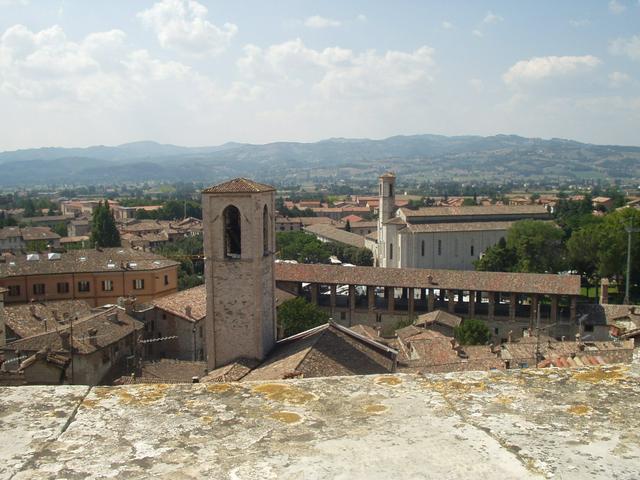Gubbio is a lovely small walled medieval city in Umbria in central Italy. It is located to the northeast of Perugia on the slopes of Monte Ingino. The city's history dates back to the Pre-Roman era.
-ftugN.medium.jpg)
- Palazzo dei Consoli. Built in 1332‑1337, this is an impressive public building. It required tremendous engineering work to create a large enough flat space on the side of a hill in order to construct the Palace, which together with the Piazza della Signoria in front of it, was erected on a massive arched structure.
- Basilica of St. Ubaldo. St. Ubaldo is the patron saint of Gubbio and his ashes are preserved in an urn on an altar in the church. The cloister is particularly attractive.
- Palazzo Ducale. An ancient palace that was restructured in the 15th Century in Renaissance style. Many of the original furnishings ended up in the Metropolitan Museum of New York.
- Cathedral. This is a Gothic 14th-century church. The façade, which was restored in the 16th century, has a beautiful Gothic portal and is richly decorated. Inside there are ten arches that support the roof. Contains some interesting paintings.

- Piazza 40 Martiri. The piazza commemorates 40 people of Gubbio shot by German forces in June 1944. A mausoleum has been erected in their honour. In the piazza is the church of St. Francis (S. Francesco), after St. Francis of Assisi who lived in Gubbio for a time.
- Fountain of the Mad. Supposedly, if you run round it three times you will also become mad!
- Roman Theatre. This well-preserved building hosts various cultural events in the summer months.
- Museo Civico, in the Palazzo dei Consoli. 10.30-13.00 and 15.00-18.00. An archaeological museum and art gallery. Notable for the Iguvine Tablets, which were seven bronze tablets discovered in Gubbio in 1444. They are also known as the Eugubian tablets. The earliest ones were probably written in the 3rd century BC. The tablets are written in the Umbrian language and shed much light on the grammar of this ancient dead language.
- Mount Ingino Christmas Tree. According to the Guinness Book of World Records, it is ranked at being the world's largest Christmas tree lit up on the slopes of Monte Ingino with over 3,000 multi-coloured lights.
Palazzo dei Consoli. Built in 1332‑1337, this is an impressive public building. It required tremendous engineering work to create a large enough flat space on the side of a hill in order to construct the Palace, which together with the Piazza della Signoria in front of it, was erected on a massive arched structure.
Basilica of St. Ubaldo. St. Ubaldo is the patron saint of Gubbio and his ashes are preserved in an urn on an altar in the church. The cloister is particularly attractive.
Palazzo Ducale. An ancient palace that was restructured in the 15th Century in Renaissance style. Many of the original furnishings ended up in the Metropolitan Museum of [[New York City|New York]].
Cathedral. This is a Gothic 14th-century church. The façade, which was restored in the 16th century, has a beautiful Gothic portal and is richly decorated. Inside there are ten arches that support the roof. Contains some interesting paintings.
Piazza 40 Martiri. The piazza commemorates 40 people of Gubbio shot by German forces in June 1944. A mausoleum has been erected in their honour. In the piazza is the church of St. Francis (S. Francesco), after St. Francis of [[Assisi]] who lived in Gubbio for a time.
Fountain of the Mad. Supposedly, if you run round it three times you will also become mad!
Roman Theatre. This well-preserved building hosts various cultural events in the summer months.
Museo Civico, in the Palazzo dei Consoli. 10.30-13.00 and 15.00-18.00. An archaeological museum and art gallery. Notable for the Iguvine Tablets, which were seven bronze tablets discovered in Gubbio in 1444. They are also known as the Eugubian tablets. The earliest ones were probably written in the 3rd century BC. The tablets are written in the Umbrian language and shed much light on the grammar of this ancient dead language.
Mount Ingino Christmas Tree. According to the Guinness Book of World Records, it is ranked at being the world's largest Christmas tree lit up on the slopes of Monte Ingino with over 3,000 multi-coloured lights.
- The Festa dei ceri is a fantastic representation organized every year on 15 May. It consists of a crazy race of three big wooden candles, each weighing around 300 kg, in the narrow streets of the city.
The Festa dei ceri is a fantastic representation organized every year on 15 May. It consists of a crazy race of three big wooden candles, each weighing around 300 kg, in the narrow streets of the city.
